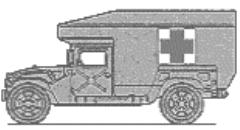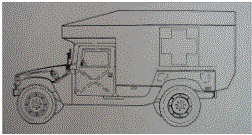|
 This
ambulance is built on a HUMVEE frame and is equipped with Kevlar armor
protection for the crew and patients. The armor protection is relative,
not absolute. It is somewhat effective against low-speed fragments. It is
relatively ineffective against high velocity small arms fire and not at
all effective against mines. This
ambulance is built on a HUMVEE frame and is equipped with Kevlar armor
protection for the crew and patients. The armor protection is relative,
not absolute. It is somewhat effective against low-speed fragments. It is
relatively ineffective against high velocity small arms fire and not at
all effective against mines.
The
M997 is capable of transporting:
 The
sequence of loading litter patients is right (passenger side) first, then
left (driver side). The sequence is: The
sequence of loading litter patients is right (passenger side) first, then
left (driver side). The sequence is:
-
Top
right
-
Bottom
right
-
Top
left
-
Bottom
left
The
most seriously injured is always loaded last and taken out first. This
means that when the back of the ambulance is opened, the most seriously
injured patient will always be on the left (driver side) and is the one
removed first.
Patients
are normally loaded head-first into the ambulance. There are a number of
reasons for this:
-
Oxygen
equipment, when available, is located at the front of the vehicle
-
Patients
are less likely to become nauseated if riding head first.
-
In
the event of a rear-end collision, it is safer.
There
are some exceptions to the general rules listed here.
-
Patients
with chest or abdomen wounds, and those recieving IV fluids should be
loaded in the lower racks, to facilitate IV fluid flow and attention
en route by medical personnel.
-
Those
with wounds to one side of the body should be positioned (feet first,
if necessary) so that medical personnel have access to the wound.
-
If
patients are being picked up from several locations, the ambulance
shouldn't be unloaded and reloaded just to maintain the severity of
illness hierarchy. Just do the best you can and let the receiving
facility know who the most seriously wounded are.
For more information, read FM
8-10-6 Medical Evacuation in a Theater of Operations
Approved for public release; Distribution is unlimited.
The listing of any non-Federal product in this CD is not an
endorsement of the product itself, but simply an acknowledgement of the source.
Operational Medicine 2001
Health Care in Military Settings
Bureau of Medicine and Surgery
Department of the Navy
2300 E Street NW
Washington, D.C
20372-5300 |
Operational Medicine
Health Care in Military Settings
CAPT Michael John Hughey, MC, USNR
NAVMED P-5139
January 1, 2001 |
United States Special Operations Command
7701 Tampa Point Blvd.
MacDill AFB, Florida
33621-5323 |
This web version is provided by
The Brookside Associates Medical Education Division.
It contains original contents from the official US Navy NAVMED P-5139, but has
been reformatted for web access and includes advertising and links that were not
present in the original version. This web version has not been approved by the
Department of the Navy or the Department of Defense. The presence of any
advertising on these pages does not constitute an endorsement of that product or
service by either the US Department of Defense or the Brookside Associates. The
Brookside Associates is a private organization, not affiliated with the United
States Department of Defense.
Contact Us · · Other Brookside
Products
|
 This
ambulance is built on a HUMVEE frame and is equipped with Kevlar armor
protection for the crew and patients. The armor protection is relative,
not absolute. It is somewhat effective against low-speed fragments. It is
relatively ineffective against high velocity small arms fire and not at
all effective against mines.
This
ambulance is built on a HUMVEE frame and is equipped with Kevlar armor
protection for the crew and patients. The armor protection is relative,
not absolute. It is somewhat effective against low-speed fragments. It is
relatively ineffective against high velocity small arms fire and not at
all effective against mines. The
sequence of loading litter patients is right (passenger side) first, then
left (driver side). The sequence is:
The
sequence of loading litter patients is right (passenger side) first, then
left (driver side). The sequence is: